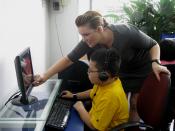EFFECTS OF POVERTY IN PUBLIC SCHOOLS
Ultimately, the free education offered to students in America should be equal to all children. Now that most states have overcome the mentality of "the wealth of the school district is based on the wealth of the community" by managing funds on the state level, per student funding is more equal throughout those states. Since passing federal integration laws in the late 1960s, teachers of middle and upper class predominantly white schools have now had to learn to deal with issues associated with teaching students from poverty stricken homes. Likewise, students from poverty stricken neighborhoods must learn how to behave in middle and upper class schools. Even though children of poverty are integrated into schools all across America, the effects on students and teachers is not always clear.
From the faculty perspective, one of the first signs a student is from a poor family is the student's participation in the subsidized meal program.
Many of these students are those who regularly attend without the supplies needed to perform their class work. Teachers have a limited budget (which may be subsidized by PTA or other programs) for supplying students with supplies. Many teachers dig into their own pocket year after year in order to help those lacking proper supplies.
Teachers must have a certain level of understanding about the student's home life situation. It is important to realize that students may have been exposed to drugs, crime, or other inappropriate circumstances. Children have a right to be angry but cannot be allowed to vent at school, and therefore, faculty must lay down the law on behavior. Likewise, if they behaved at home like they are expected to in school, they would be ostracized. Their attitudes, slang, and attire in the hood is often a necessity...


